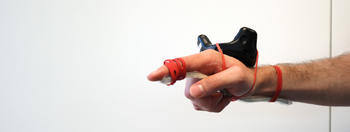Blink-Suppressed Hand Redirection
Leveraging Blink-Induced Change Blindness for Hand Redirection in VR
Many interaction techniques in virtual reality break with the 1-to-1 mapping from real to virtual space. Instead, specialized techniques for 3D interaction and haptic retargeting leverage hand redirection, offsetting the virtual hand rendering from the real hand position. To achieve unnoticeable hand redirection, however, the utilization of change blindness phenomena has not been systematically explored.
Inspired by recent advances in the domain of redirected walking, we present the first hand redirection technique that makes use of blink-induced visual suppression and corresponding change blindness. We introduce Blink-Suppressed Hand Redirection (BSHR) to study the feasibility and detectability of hand redirection based on blink suppression. Our technique is based on Cheng et al.'s (2017) body warping algorithm and instantaneously shifts the virtual hand when the user's vision is suppressed during a blink. Additionally, it can be configured to continuously increment hand offsets when the user's eyes are opened, limited to an extent below detection thresholds.
In a psychophysical experiment, we verify that unnoticeable blink-suppressed hand redirection is possible even in worst-case scenarios, and derive the corresponding conservative detection thresholds (CDTs). Moreover, our results show that the range of unnoticeable redirection can be increased by combining continuous warping and blink-suppressed instantaneous shifts. As an additional contribution, we derive the CDTs for Cheng et al.'s (2017) redirection technique that does not leverage blinks.
The novel technique of Blink-Suppressed Hand Redirection and the results of the conducted user experiment are presented in the Bachelor's Thesis by Kora Regitz and in the corresponding paper published at IEEE VR 2021.
Blink-Suppressed Hand Redirection
André Zenner, Kora Regitz, Antonio Krüger
Proceedings of the IEEE Conference on Virtual Reality and 3D User Interfaces (IEEE VR 2021)
DOI: https://doi.org/10.1109/VR50410.2021.00028
PDF (Full Paper)
